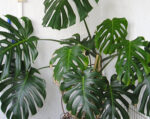The tropical Split Leaf philodendron plant is often called, mixed up with, and interchanged with a Monstera deliciosa plant or Swiss cheese plant. Although both plants are in the same large Araceae family, have the same care requirements, and grow in a similar manner, they are not the same plant. The Split Leaf philodendron plant is a close relative of the pothos plant. The Monstera deliciosa, found in Mexico and often grown for its “breadfruit,” is a close relative of the Peace Lily plant (Spathiphyllum).
A Split Leaf philodendron, sometimes called a Lacy Tree philodendron or Horsehead philodendron, is a very large, popular, easy- care houseplant. These plants have big, glossy, leathery, heart- shaped leaves that, as the plant matures, split from the leaf edge to the center vein. The slits in the leaves of a Split Leaf philodendron are called cuts. When young, a Split Leaf philodendron plant has strong upright stems. As the plant grows larger and the leaves get bigger and heavier, the philodendron stems start to droop down until they are almost horizontal to the ground. A Split Leaf philodendron grows rapidly indoors, especially if the humidity is high, and often has leaves that are as large as 3ft. long and 2ft. wide. When grown as a houseplant, it takes about 15–20 years for a Split Leaf philodendron plant to produce flowers. Eventually, an indoor Split leaf philodendron plant grows to be about twice as wide as it is tall and takes up quite a bit of space in your home or office.



Monstera deliciosa Swiss Cheese Plant Variegated Split Leaf Philodendron
The leaves, stems, and roots of a Split Leaf philodendron contain oxalic acid and the plant is considered very poisonous. Read more about common houseplants that are poisonous in Don’t Feed Me to Your Cat: A Guide to Poisonous Houseplants. If you want a big, tropical, low maintenance plant and have plenty of room, a Split Leaf philodendron plant is perfect.
Plant Care
Light
A Split leaf philodendron needs medium to bright light. It can survive in lower light, but the leaves won’t split and the plant becomes leggy. Keep it out of the direct sun.
Water
Water a Split leaf philodendron well, until the water drains out the drip holes in the bottom of the pot. Allow the top 25-30% of the soil to dry out before watering again. Keep the soil of a Split leaf philodendron damp but never soggy. Water droplets or perspiration on the leaves of a Split leaf philodendron indicate over-watering; brown leaf edges indicate under- watering.
Fertilizer
Feed a Split leaf philodendron every two weeks when the plant is actively growing with a balanced plant food diluted to 1/2 the recommended strength.
Temperature
A Split leaf philodendron plant prefers warm temperatures and doesn’t do well in temperatures below 50°F (10°C) .
Humidity
High humidity helps a Split leaf philodendron grow faster, but the plant can adapt to household humidity.
Flowering
A Split leaf philodendron usually takes about 15-20 years to flower indoors.
Pests
Split leaf philodendrons are fairly immune to plant pests; but If mealy bugs, spider mites, aphids, or scale appear, use the Green Solution (recipe in Glossary).
Diseases
Because of the high humidity a Split leaf philodendron prefers, bacterial diseases such as Erwinia Blight, Xanthomonas leaf spot, and leaf tip burn can be a problem.
Soil
Split leaf philodendron grows well in a rich soil that contains a good amount of peat moss and drains quickly. Using this type of soil prevents root rot.
Pot Size
Unlike most indoor plants, a Split leaf philodendron prefers to be in a large pot. Using bigger pots promote larger philodendron leaves.
Pruning
Try to keep the large, shiny leaves of a Split leaf philodendron clean and dust free. This plant needs to be aggressively trimmed or it will take over your room.
Propagation
The best way to propagate a Split leaf philodendron is by stem cuttings. Be sure to include a few leaves and a few plant nodes on each stem cutting and to allow the cutting to sit out over night before planting them; this helps prevent the developing roots from rotting.
Poisonous Plant Info
A Split leaf philodendron is very poisonous houseplants with a #2 toxicity Level.
FAQ
Brown leaves and edges on a split leaf philodendron usually mean that the plant needs more water, especially in the warm weather; or more humidity, especially in the winter when the heat is on. Keep the soil a little moist but never soggy. To increase the humidity, you may have to put your plant on a tray of pebbles filled with water (be sure the plant sits on the pebbles and not in the water), use a humidifier near the plant, or group three or four plants together to increase the humidity.
Sounds like your split leaf philodendron is over watered. Reduce your water and move the plant to a brighter, warmer location so the soil has a chance to dry out faster.
Leaves are small and don’t develop splits, or cuts as they are sometimes called, occurs when the plant is not getting enough light. Move the plant closer to a window but avoid direct sun.
I think the long, brown stem-like things you are referring to on your split leaf philodendron are air roots. In nature, these air roots help support the very weak-stemmed split leaf philodendron. You can plant them in the soil to give the plant more stability or but cut them off if you find them too unattractive.
A split leaf philodendron likes to have plenty of room for its roots. Larger pots encourage larger leaves. If you want your split leaf philodendron to keep getting larger, repot annually. If you want to limit the size of your plant, stop repotting it.

